#Occult book reviews
Text
Reading Journals!? Why You Really Should!!

I'm writing this to promote the concept of reading journals in general for occultists!
It often seems like, while a lot of us read a ton, we don't engage enough with what we read. It's very important to think critically about the information we consume.
Keeping records of it can be helpful for that. While not everyone's going to vibe with it, I do recommend giving it a try for most witches, diviners, wizards, etc... you might like it. Keeping a reading journal? It has some advantages IMHO.
I found it works very well for keeping track of my reading goals. It also helped me engage more with what I was reading. I think this produced an altogether more interesting experience when reading fiction, too.
I learned more when reading nonfiction, and it helped prep reviews for this very website, too. It's kind of hard recently, because of health issues, but I want to keep a daily reading habit as best I can. I might change up my journaling format, though, which I'll discuss towards the end of this article.
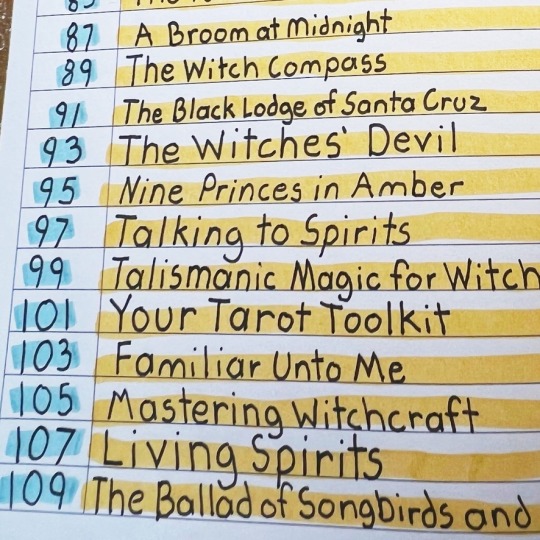
To begin, you need a journal. Any blank notebook will work. A lot of people swear by dot grid journals. I use those for most other things. For my reading journal, I bought a pre-printed one called Kunitsa, and there are others on the market, too.
Beyond that, you only need a pen. I use a lot of highlighters and other color in my reading journal, to make tracking things more fun. Next, you're going to want to include a table of contents for your reading journal if possible. In fact, I recommend doing that for all journals, but that's another story entirely. If you pick a pre-printed reading journal like mine, choose one with such a feature.
If you're a DIYer, leave a few blank pages at the beginning of your notebook for the table of contents. Usually four or five pages will do for a table of contents, depending on the size of the journal itself. Including a table of contents can also help get past those first-page jitters if it's a blank book.
A reading journal can include an inventory of your library. My own library is digital because I have to cross the Atlantic on a frequent basis. Those with physical books might find it useful to catalogue everything, particularly favorites.
This could even include where it's stashed. Given that I could easily print a list of mine, my journal doesn't have this, but yours could. You could also organize your library based on the criteria of your choice. I do this digitally, and it can be great to be able to pull out a list of (for example) all the Tarot books I own, favorites, etc..
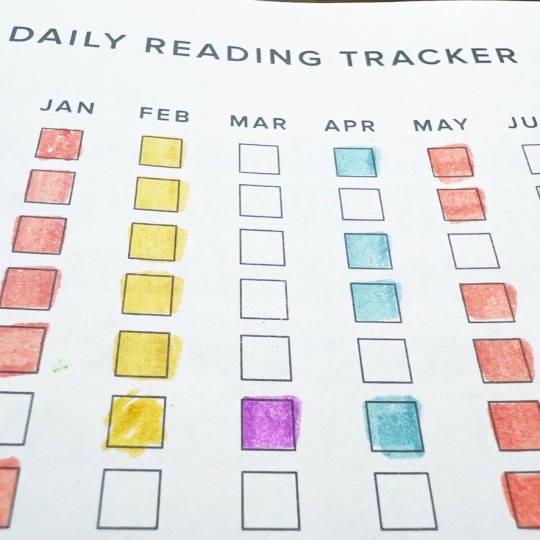
Keep track of your reading goals! This is the big one, of course. I try to read at least thirty minutes per day, and I log each day I meet that goal. A reading journal can include a simple daily reading tracker like mine, or variations on that.
Some people might track how many pages they've read, or even chapters, for example. You can, of course, include your To Be Read list, adding to it and crossing out as needed.
Keep track of books, authors and topics. You'll want to include a page or two for each book you read, with meaningful quotations and your own thoughts. Some people get quite elaborate with this, including diagrams, images, and such.
I stick to quoting the parts I found important, then adding my own notes. If you buy a reading journal, choose one formatted for both fiction and nonfiction. These little "spreads" on each book help a ton if you want to prepare reviews later on, or just to keep track of what you’ve read for the future.
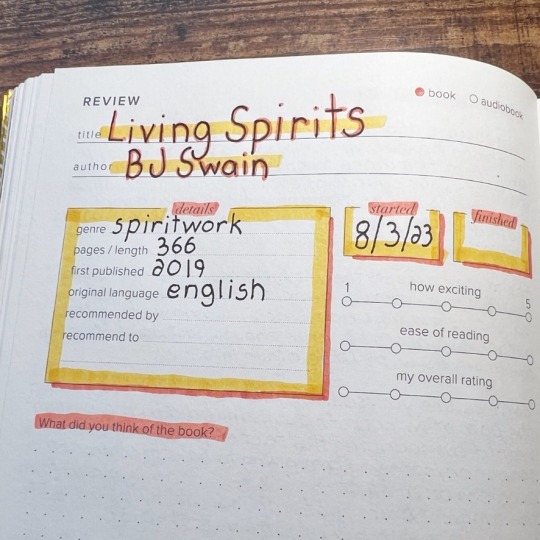
The reading journal I've been using has a section for borrowed books. Since all my books are Kindle, and I don't typically borrow books, I repurposed this for my review schedule. You can create your own spread for that kind of thing if you're doing a DIY approach, which would be even better.
Because I didn't see a use for the first two pages of the notebook, I turned them into a little pocket using washi tape. I figure that if necessary, I can include extra trackers/etc on my own paper in the pocket. I haven't done that yet, but I probably will in the new year. Currently, the pocket only contains some unused stickers.
You could, of course, get much more complicated with a reading journal! It's all up to you. I plan to use a similar setup next time around, but doing it myself in a (larger) dot grid notebook. The preprinted version of a reading journal worked well to get me started. Now that I've got the basics figured out, I want to customize things more.
All and all, I know most occultists love journaling. At least, many of us do. But why don't more of us journal about what we read? Dedicating a notebook just for a reading journal worked great for me, and might work for you, too.
I'd look into different options (preprinted, blank notebooks, digital) before getting started. Don't be afraid to mess up, like with any new notebook. It can become a way of looking deeper into what you're reading, though.
#witchblr#magic#witchcraft#witch#occult#witch community#eliza.txt#journal#books#reading#studyblr#journaling#bujo#bullet journal#bullet journaling#writing#readblr#netgalley#reviews#eliza reads
96 notes
·
View notes
Text
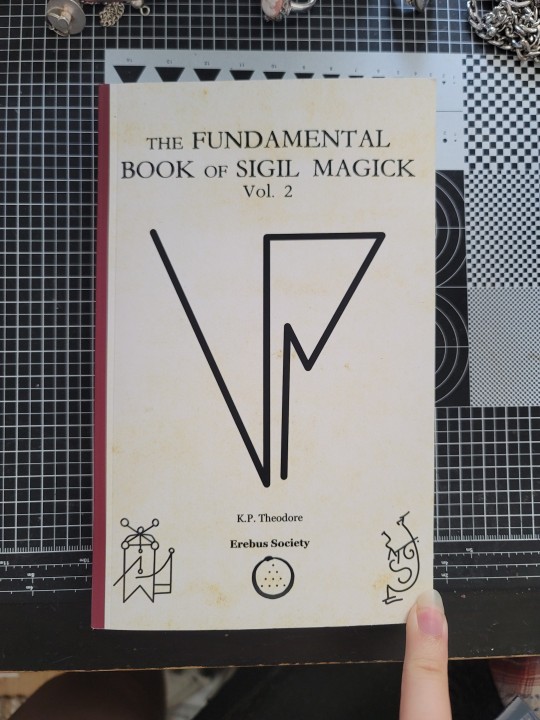
Okay so there is a book two of the sigil magic guide by K. P. Theodore and girl. GIRL! The other book didn't have any bullshit in it, and if you would like my quick thoughts on it check out this post, but this one introduces some bullshit.
Okay so the first two parts about what kind of sigils are there and how to make them is just the repetition of book 1 minus the pictorial method. That is fine besides this ugly ass sigil. Like girl i know you can use Adobe Illustrator way better than that cmon!
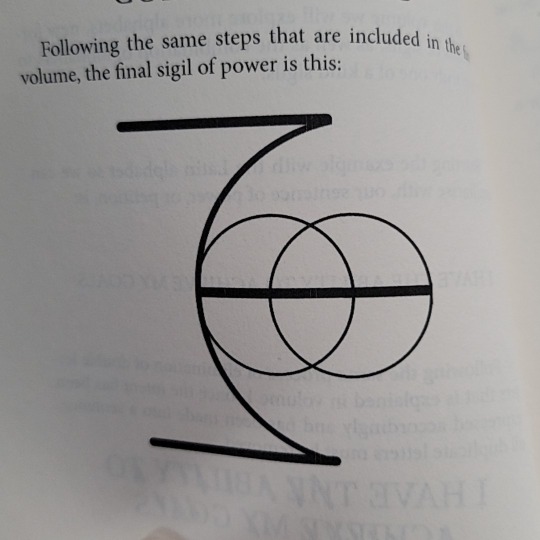
But anyways, here comes the bullshit. What isn't bullshit is the idea of using other scripts and languages other than English to make sigils. That is fine and if anyone figured out how to make sigils with a logographic or syllabic languages good for you and you can go ahead and use that.
Also this magi alphabet is fine it's just uh it's an occult way of writing Hebrew so that's iffy and idk if Theodore is Jewish. If this is your culture you're fine using this but still 💅

Here comes the bullshit:

This is NOT the enochian alphabet. THIS is the enochian alphabet

Then what is that alphabet then? The theban alphabet. What is the theban alphabet then in the book?
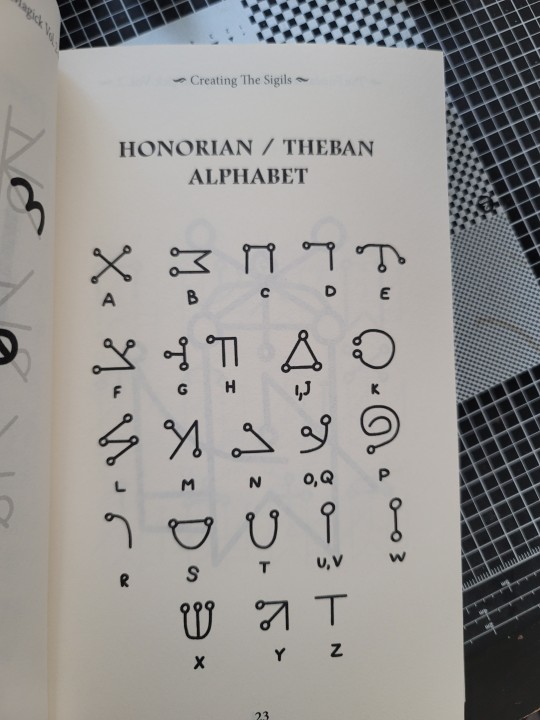
THIS IS NOT THEBAN. THIS IS CELESTIAL! oh boy then what is celestial???
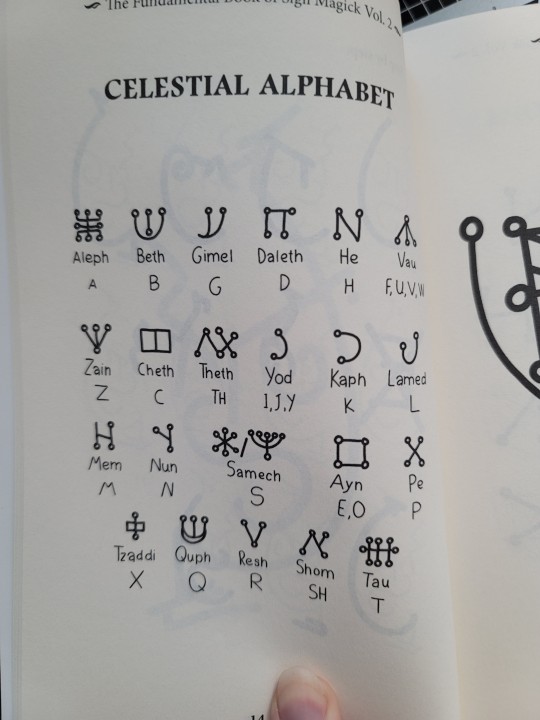
Do not let your eyes deceive you! This is not the celestial alphabet, this is the malachim alphabet. Both celestial and malachim are both a way of writing Hebrew for occult workings and I get it Theodore they look so similar! BUT YOURE AN OCCULT BOOK WRITER! YOU NEED TO GET THIS SHIT RIGHT! And by the way uh wanna know what the malachim alphabet is??? Before I start going insane???

Wh-WHAT IS THAT??? HUH??? WHERE ARE YOU GETTING YOUR SOURCES FROM THEODORE BECAUSE I CAN JUST FUCKING GOOGLE THIS SHIT TO FACT CHECK! I AM GOING TO BUY THAT OCCULT BOOK THAT YOURE APPARENTLY REFERENCING BUT FAILING TO EVEN REALLY READ IT!
Which is this
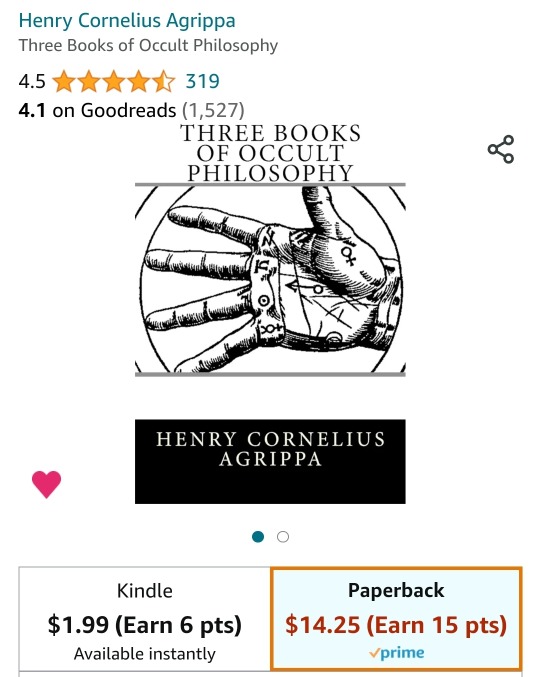
But it doesn't stop there. Oh no no no no! The bullshit hasn't stopped! It only begun! AND IVE RUN OUT OF HOW MANY PICTURES I CAN UPLOAD ON A POST VIA THE APP SO THIS IS GOING TO BE A THREAD!
please check the notes for the continuation of the bullisht
31 notes
·
View notes
Text
What are you currently reading?
Paganism, Polytheism, Witchcraft & Occultism Edition
Reblog with your answer: title and author and how you're liking it so far, or put it in the tags!
#currently reading#paganism#paganblr#witchcraft#witchblr#occultism#occultblr#polytheism#book recs#book review
51 notes
·
View notes
Text
💀 THIS WEEK 📅

✨THR | memes
✨FRI | occult book review
✨SAT | elden ring
twitch_live
#vtuber uprising#vtubers are live#tarot#envtubers#elden ring#tarot readings#indie vtuber#vtuberen#vtuber#vroid#envtuber#twitch#twitch streamer#twitch affiliate#3d vtuber#Vtuber Uprising#ENVtuber#vtubers of tumblr#occult books#book review#mothmom updates
14 notes
·
View notes
Text
So, it's been a while, but some of you may rember I write book reviews for Paralibrum occasionally. This one is from a while back but has just gone live: MAGIC IN MERLIN'S REALM: A HISTORY OF OCCULT POLITICS IN BRITAIN, by Dr Francis Young.
I love this book because it upends a chunk of modern dogma that 'magic' was solely fringe, and not something that has been alongside and intertwined with politics and power of all stripes - from the rebel to the monarch- recorded for over a thousand years.
By using the figure of Merlin as created by Geoffrey of Monmouth, Young provides a lens for us to understand that the idea of the magical practitioner was not confined to solely peripheral figures such as the proverbial witch on the edge of the village but that the image of the magus is its double, found at the heart of mediaeval, early modern, and even modern politics – often at the heart of British court life. As Young points out, however, court life does not necessarily mean at the monarch’s right hand – yet in some cases, British monarchs deliberately cultivated the image of a Hermetic magus:
As much as masques and architecture, the temporary architecture and elaborate decorations which accompanied Stuart royal processions in London constituted ‘a form of ceremonial magic centred on the image of the monarch as the sun’. (loc. 5764)
With Merlin comes Arthur, the rightful, legitimate king of the Britons. This is something Young makes abundantly clear – that several monarchs and dynasties have used the mythological grounding of Arthur, Solomon, and the persona of a Hermetic magus, as proof of legitimacy in the face of rebellion or political unrest. Yet, as he repeatedly shows, even at the most cynical, such marriages of political, mythological and occult power were used because people believed in magic. It was part of the worlding performed – its imagery operated in a “cult of the visual”, which was for, at least the Tudors, also a “cult of chivalry […] a cult of occult wisdom” with ‘“a dark side [which] was the potential magical misuse of pictures of the monarch. Elizabethan culture was preoccupied with double meanings, so that symbols (like the Tudor rose, itself a symbol of secrecy as well as a dynastic badge) were frequently suffused with occult power and significance.” (all loc. 3822)
Such things reach further back: the Norman kings promoted Geoffrey of Monmouth’s Merlin because he prophesied their coming, allowing them to position themselves as just one more proper phase in the history of Britain. Further, Young highlights that William I himself is recorded as “engaging a female magical practitioner” against Hereward in the earliest record of a monarch employing a practitioner. This raises the idea that the Normans’ reliance on Merlin and his prophecies meant that “their own self-representation effectively depended on an occult tradition.” (loc. 2355). Rather than Arthur, however, it was new shapes of knowing and knowledge from the Islamic world – preservations and iterations on, and of, Hebrew, Graeco-Roman, and Egyptian understandings – which began to move more strongly into the worldings of magic in Britain post-Conquest.
13 notes
·
View notes
Text
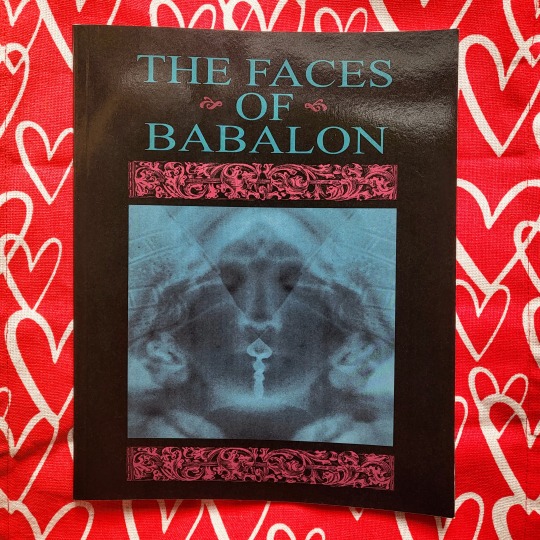
Faces of Babalon - Mishlen Linden (editor)
The Faces of Babalon is a collection of essays written by a small group of cis women that have connected with the deity in a meaningful way. The essays are brief, not more than 30 pages and self-described as a chapbook, and bracketed by channelled messages from D. Koons.
The authors are a mixed bag. Assuming I have found the right people: Linda Falorio was an artist that created The Shadow Tarot as well as a psychotherapist (according to an obituary), Soror Chen does not exist online as far as I could find, Mishlen Linden is a fine artist that mixes spirituality with sculpture and has contributed to other books on Babalon, Nema’s name is to vague to find any results, and the main result for Raven Greywalker is an essay on Thelemic sadomasochistic magic rituals (which is fitting with her essay).
The essays are dense with information and all of them are heavily based in a mix of sex magic, the various aspects of Babalon as a figure and as a deity, and with a liberal helping of appropriation of chakras, east Asian concepts, and Kabbalah. In my opinion, the first is the best.
I have read this book twice now, once as a PDF and once as a print copy that I now own. The writing that focuses exclusively on Babalon is intensely interesting and explorative in a way I’ve not seen in other books (yet). It probes unmarked territory in ways of conceptualising the goddess and includes gender expansive and trans readings of Her, as well as being a collection of essays written without the influence or need to cater to cisgender men. One essay plunges into Babalon as a sex worker - something often alluded to in other writings but shied away from confirming or exploring deeper.
A few essays are intensely critical of Crowley & his attempts at constructing Babalon as a goddess that is both liberated but submissive to men, a welcome read considering some writings on Her.
I do not recommend this book at all for beginners to metaphysical or religious practice, since the appropriation is mixed in with non-appropriative writings on Babalon and may be hard to parse in parts (in other parts, it’s incredibly blatant and obvious), however I do recommend it for those experienced in picking appropriation out from a text and interested in different and unique views on Babalon.
posted first on my patreon
#The Faces of Babalon#book review#occult book#babalon#babalon thelema#babalon deity#babalon devotional#babalond
13 notes
·
View notes
Text
Book Review - The Magic of Marie Laveau
I stumbled upon this book by accident one day, while browsing after a routine checkup with my doctor. Luckily for me, I have a Barns and Noble near my doctor’s office so after every visit (which is annually), I reward myself with a book. This visit though, I wasn’t interested in my usual fiction genre that I’ve been accustomed to reading; I wanted to venture out into something new which is how I…

View On WordPress
#blog#blogger#blogging#book#book review#hoodoo#Laveau#magic#Marie#mother#occult articles#recommendation#reference#review#spirituality#voodoo#witch#wordpress
4 notes
·
View notes
Text
BOOK 1: THE BACCHAE BY EURIPIDES
Very good, very tragic, not indicitive of my experience with Dionysus, but an important middle point in the history of his mythology, in the transition from Mycenaean to Orphic to The Bacchae to fun party guy Bacchus. My gripe would be entirely personal, it potrays the God a bit petty for my liking. 4.5/5
3 notes
·
View notes
Text
Magicka by Carlota Santos: ⭐️⭐️⭐️

Review:
First impressions; I thought this book was beautiful. The simple folk art vibe, the deep green hardback. When first skimming through the pages, there was a variety of info. It seemed interesting and like a decent read.
Jumping in, I was disappointed. It was another "list" style book. It very, very quickly (1 page each with a big picture, or if that) over what "X" is in a magical sense.
Although, yes, it is helpful, it is not thorough. It shoves very basic and minimal info at you about astrology, the sabbats, the moon, and her phases. Some divination is thrown in there as well, herbs, the usual stuff. A lot of which you'd find with a few Google searches. It can definitely give a new practitioner a decently rounded foundation of knowledge, but I feel as though readers might still be left feeling unsure.
This is where I was dissatisfied. I love a quick and to the point read, but for articles. This book did feel as though someone did a very quick search and looked at the first link they found for the "X" part of the craft.
Overall, I give it a 3/5 rating because it's fine. Not one I would highly recommend, but not one I would steer people away from either.
5 notes
·
View notes
Text
A New View into Dark Academia with The Cloisters
The Cloisters by Katy Hays dips into a new side of dark academia for me, one which has spurred a wave of curiosity from deep within, and that is art history. Art history is one of those subject that I wanted to take at school but my subject choices didn’t align right for that to happen so getting that art history immersion through Ann (just one letter off!) and this mesmerising read was truly a…

View On WordPress
#the cloisters#katy hays#met cloisters#the met cloisters#the cloisters musuem#dark academia#occult studies#tarot studies#art history studies#gothic thriller#mystery thriller#dark academia books#dark academia reads#adult fiction#book review
3 notes
·
View notes
Text
ARGH I FINALLY FINISHED AGRIPPA
#the moon speaks#occult fun times#TOOK ME A FUCKING *YEAR* BECAUSE IT'S LIKE 800 PAGES OF DENSE TEXT#technically 1000 if you include the footnotes (which will be needed because it's Agrippa)#i know it's technically 3 books but it was fun but i just wanna move on now#review: dont take Hebrew classes from him
2 notes
·
View notes
Text
"Court cards are weird. There, I said it. They throw everybody off when they’re first learning to read tarot cards. Many older/more traditional tarot guidebooks will tell you that court cards always represent specific people in your world. I’ve found that to be a limiting way of looking at them."
From the beginning of Your Tarot Toolkit, by Ru-Lee Story. It's from a review copy obtained through NetGalley program, am working on a full review.
#witchcraft#tarot#divination#witch#magic#occult#tarot cards#cartomancy#eliza.txt#eliza reads#netgalley#ru-lee story#your tarot toolkit#court cards#book review#book#books
44 notes
·
View notes
Text
Hekate: Goddess of Witches
Book Review by Buggabeewitch

I’m going to do this in sections, I have so much to cover. TL;DR, I loved this book and highly recommend it to witches interested in Hekate, people who are just beginning or already somewhat on their path with Hekate, or just any witch at all, whether you want to work with Hekate or not, you can still glean much wisdom from this book.
Parts:
Disclaimers and Prefaces
Moon Goddess?
Goddess of Witches or Witches of the Goddess
Thoughts on the Included Rituals and Spells
Shadow Work
Conclusion and Final Thoughts
Part One: Disclaimers and Prefaces
I don’t have anything to disclaim about this book, actually, other than that I picked it up on a whim and didn’t research the author beforehand. I still haven’t researched the author. I’m saying this because if anyone has an information about her in regards to her being a bad person, an appropriator, etc, as many occult authors are, I’m not claiming to defend her of those actions. I’m reviewing the book, not the author. However, if there are any ghosts in her past, bring them to my attention and the attention of others. Such “ghosts” are not always irredeemable, but are important to bear in mind when reading the works of someone who has them in their past.
This section is mostly about disclaimers the author makes, and how I’m so glad she made them!
Weber often times throughout her book references safety as of the utmost importance. She makes sure to mention that when she has done work outdoors or in the dark of night, that she does not go alone, that she does so at crowded times of day.
She makes the distinction between modest discomfort and damaging traumatic experiences, which is important. Discomfort is nothing to shy from, and is vital to confront at times; but this doesn’t mean endangering your physical, emotional, or psychological well-being. That must be avoided and “refused,” as Weber states very clearly.
She makes sure to mention that neo-pagans may refer to Hekate as a triple-goddess, with the maiden/mother/crone (m/m/c) archetype. She does not regard Hekate as such, to my understanding, but does make sure to mention where this very modern idea of Hekate comes from. She is Hekate Triformis, she has some connections with lunar magic, and thus has been syncretised, wrongly, in my opinion, with that m/m/c archetype by modern neo-pagans, namely wiccans.
When Weber discusses how Hekate is referred to as “dark,” and explains how “darkness” is not to be feared or strayed away from, and how those who work in “dark” places or fields are often the kindest and most caring among us, she makes sure to mention her opinion on the use of the terms “dark” and “light,” or “black” and “white” magic. That being that they are not good terms, they don’t describe what you actually mean, and that they have overtly racist origins. A very important note for those beginning in witchcraft who are likely seeing those terms thrown around flippantly by those who either don’t know better, or are just plain racist, or are actively choosing not to confront the problems with those terms. To those of you who come to this news fresh, consider “baneful” and “beneficial” magic instead.
Part Two: Moon Goddess?
My only major gripe with this book is the continual reference to Hekate as “lady of the moon.” I didn’t personally associate Hekate with being of the moon, and actually saw references to her as such as being a red flag for those who syncretise Hekate with that m/m/c archetype. However, Weber backs up her reasons for calling her such. There’s many well-researched and cited sources for her associations with the moon. Weber mentions Hekate’s syncretization with other Greek and Roman goddesses who are more historically and more closely related to the moon (such as Selene and Artemis). Also, she goes into her origin story with Hekate as a moment when she looked up to the moon and said “I’m Yours.” So maybe she associates Hekate with the moon so strongly because Hekate appeared to her in a moment of Epiphania through the moon on that night.
Whether you want to take that as Weber’s “UPG” or as something truly well-founded, is up to you, really. Personally, I won’t be calling Hekate the “lady of the moon” any time soon. But I respect Weber’s choice to do so. I respect that that’s her relationship with Hekate. And honestly, she brings up historical and mythological sources for Hekate’s lunar connections, so while I still wouldn’t call her a “moon goddess,” or a “goddess of the moon,” per se, I would say she has connections to the moon. And therefore, the moon can be a symbol of Hekate. Hope that made sense.
Part Three: Goddess of Wicthes, or Witches of the Goddess?
In Fel the Blithe’s YouTube series on Hekate, Fel raises the question, is Hekate a witch and has Hekate always been associated with witches, or has her association with witches developed over time because of her characteristics, retinue, and attributes (such as crossroads, torches, certain animals, etc) being considered “witchy.” I know I phrased that question poorly, but I hope you can still gather the gist of it.
It’s interesting to ponder that question. It seems to be Weber’s belief that Hekate is the Goddess of Witches (it’s literally the name of the book, after all). I don’t think taking either side makes you more right or wrong, actually, because ancient and modern worship are both equally valid and true. Whether she came to be known as a goddess of witches later or always has been, to me, is unimportant. It’s seems that she’s a “witchy” figure regardless, and therefore can be known as a patroness of witches whether that’s historically founded or not. Whether modern witches have her that title or if she always had it, again, to me, isn’t very important.
In the book, Weber goes into being the Family Witch. She relates Hekate’s family and history to one’s own family and history. She tells how Hekate is well respected, or feared; rejected, or often come to in times of need; how she is often the only one to step up in times of fear or discomfort (see the myth of Persephone’s Abduction, specifically Demeter’s search for her daughter). Does that not sound familiar? Yeah. Sounds a lot like being the only witch in the family, which is a truth many of us live. So whether Hekate was always a patroness of witches or not, it seems, and Weber would certainly argue, that she certainly has all the necessary qualifications for being such now.
Now, I’m still learning about how I feel about that question that Fel raises. I’m not saying that Weber’s belief is correct, or that the opposite is true. I’m saying that it’s important to ponder and that, for a third time, to me, the conclusive answer isn’t of vital importance and it may not exist. Hekate is a goddess of mystery. This is just one mystery of many. Plus, I think it’s just important to ponder it for yourself when you go into reading a book where the author does clearly pick one side of that coin.
Part Four: Thoughts on the Included Rituals and Spells
TL;DR, I loved them. I found them to be incredibly customizable and most importantly accessible. She takes care to mention that you don’t need to follow her words to the tee. She says specifically that her rituals are not a “prescription” but a guide or suggestion. Weber offers both modern and ancient rituals, hymns, and prayers. While historically rites to Hekate were preformed at crossroads at midnight, there’s nothing wrong with doing them during the day in your backyard or in your home. As Hesiod says, and I’m heavily paraphrasing, one who offers little but often is more pious than one who offers much but rarely. Doing the best you can is all the gods of our religion can ask of us! Weber takes care to mention that you shouldn’t put yourself into perilous situations or run yourself into debt in order to offer to the gods. She says specifically to view an offering to a god like an offering to a guest in your home. If all you have is cookies and coffee, then offer cookies and coffee! Sober and/or can’t have alcohol in the house? Offer soda or clean water! Do. Your. Best.
I found her rituals to be helpful especially because she explains the purpose behind what she’s suggesting. She’s not telling you to Do A Thing and then expecting you to understand why. Knowing why she’s offering a certain idea is important because it gives you the tools to adapt that suggestion to your own practice.
One such ritual for protection, she writes to first draw the outline of a dog and to write the names of those you need protected. Dogs are sacred to Hekate, and are well known guardians and companions. If dogs terrify you, or if horses are more your thing, or even cats, then you’re welcome to draw that instead of a dog. Because it’s your practice. What you do is personal, and that’s what makes it special and a powerful bit of magic for you in your life.
Part Five: Shadow Work
Weber does not mention the phrase “shadow work.” She does about twice or thrice mention the word “shadow,” but never the phrase “shadow work.” However, she does describe it. She describes times in her life when she needed to face ugly truths, or when clients of hers needed help confronting their fears or personal ugliness at a metaphorical crossroads. She describes when Hekate appeared as a epiphany in an ugly time to light the way. She describes how it’s important to do things that are modestly uncomfortable, and how some of the most powerful magic comes from an uncomfortable place. She describes how working through your past, confronting the hard parts, and bettering yourself before vowing to help others is important. Doesn’t that sound an awful lot like shadow work?
The way she describes Hekate’s role in these parts of the book makes it seem like Hekate is a great facilitator of shadow work. She’s not going to do the work for you — no, no, no — nobody can do that but yourself. But she describes Hekate as an important guide or helping hand in these times. Shadow work can be hard, it can be scary, but it’s often necessary for self improvement and moving forward in life or even just in your practice. This was a comforting as well as interesting takeaway from the book!
Part Six: Conclusion and Final Thoughts
I loved this book. I have few gripes, like the aforementioned continual reference to Hekate as “lady of the moon,” or the implication that witchcraft is it’s own spirituality or religion rather than a path that can include spirituality or religion, or not.
Weber’s book includes many personal anecdotes, which to some readers may become tiring when you’re here to learn about a goddess and not about a priestess. However, I personally loved the anecdotes. I feel like sharing moments of divine epiphany and other personal stories can show how a deity can impact one’s life in a way something more impersonal just can’t. It’s comforting sometimes to hear from a modern human how a deity can take form, it’s helpful to hear from a modern human how rituals and spells can look in the modern day. So for those reasons, I really didn’t mind those bits.
Again, if you’re interested in Hekate, or in witchcraft, namely in religious or specifically hellenic witchcraft, or in sprits and the dead, this book has something for you. I just finished the book this morning so I haven’t had much time to put any of my new learnings to practice. However, I will report back. That’s a promise.
Thank you for reading! Have a blessed day!
Sincerely,
Sonny Sunshine
#hekate: goddess of witches#courtney weber#courtney weber author#hekate#witchcraft#witches#witch#hellenic goddesses#hellenic goddess#my post#buggabeewitch#helpol#hellenic polytheism#hellenism#hellenismos#hellenic polytheist#book review#occult book review#occult book#occult books#witchcraft books#book reccs#book reccomendation#book recommendations#witchcraft book
30 notes
·
View notes
Text

A Friendly Hello
Hi there, my name is Art and I'm starting an occult bookshop. This page is devoted to my bookshop, I'll be posting books I find, read and (eventually) sell! I've been into the occult and the paranormal since I was a kid and I love books about as much as I love those subjects, so it made sense to me to roll my favorite things into one fun business idea! Eventually, I plan on creating a website for my bookshop. My dream is to start a physical bookstore one day as well.
I plan on selling occult books (including books on witchcraft, other magic systems, history of the occult) as well as other non-fiction books I enjoy. I love cryptozoology, the paranormal, history, science, and poetry so you will absolutely see that peppered in here. Please enjoy and don't be afraid to reach out to me if you want to talk about books or ask questions.
Happy Reading!
Art
#occult#paranormal#cryptozoology#history#science#bookshop#bookseller#online bookseller#bookblr#book review#non fiction#occult books#witchcraft#traditional witchcraft#wicca
2 notes
·
View notes
Text
Hello!
Hello People of the internet....
here I will share with you reviews of classics, occult, mystic, metaphysics, mystery, philosophy, alchemy, poetry and many more books from a variety of genre's. I hope you enjoy my blog...
CHECK ALSO -> https://www.tumblr.com/blueheartbooks !!!!

#bookreview#books#book#occult#mystery#hermetic#book blog#book review#occult books#occultism#magick#esoterism#mysticism#classics#mythology
6 notes
·
View notes
Text
My review of Hermetic Spirituality and the Historical Imagination is now up
Been working on this the last couple of weeks - now up at Paralibrum. It was fun to work on and may annoy some folks. Hope you, and they, enjoy it.
"For this was not about magicians “gaining power” in conventional modern senses, but ritual specialists (priests) creating conditions for those involved to be able to apprehend the gods, and in that apprehension, be “lifted” from the contouring and structures of ordinary existence. Nor should it be assumed that the “lifting” necessarily implies a spatial hierarchy as perhaps our modern language might suggest. It is quite simply then, creating “set and setting” for the gods to engage. That kyphi or the respective incense might have acted in concert with the nervous system to enhance the experience is not some sort of gotcha to suggest everyone was high and therefore the experience was merelychemically induced. Quite to the contrary, because, as Hanegraaff suggests, “Alterations of consciousness result in altered states of knowledge.” (p.3) To meet and have congress with the gods was the point – and in doing so be acted-upon. Thus, it is about acquaintance, understanding, rather than description.
So how are we to understand what those involved experienced? Hanegraaff suggests that we do so by considering that the gods reveal themselves to those involved, and it is by that divine appearance, by presence, that the body and soul are revealed themselves, and reconstituted and purified. It is not that the body, or the matter itself is corrupt or evil per se, rather that it has to be treated-with/by-divinity, which comes through the re-cognition of the faculty of imagination.
The faculty of imagination, as related to nous, is fundamental to the actuality of existence. It is not some poor, deluded, dreamy mooncalf of a distant cousin, but the faculty and power of the gods themselves. "
35 notes
·
View notes